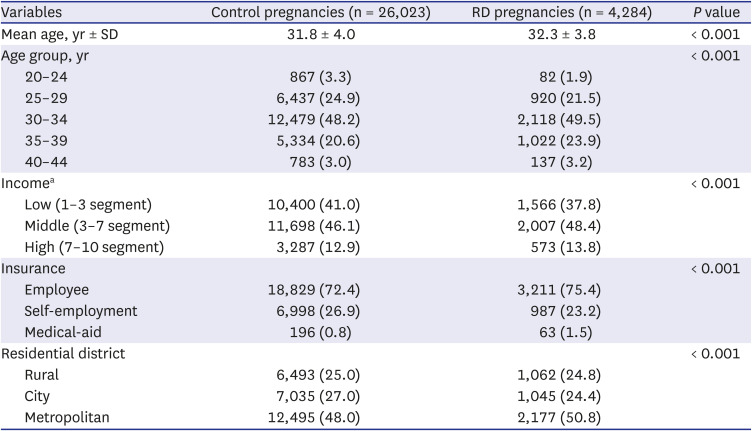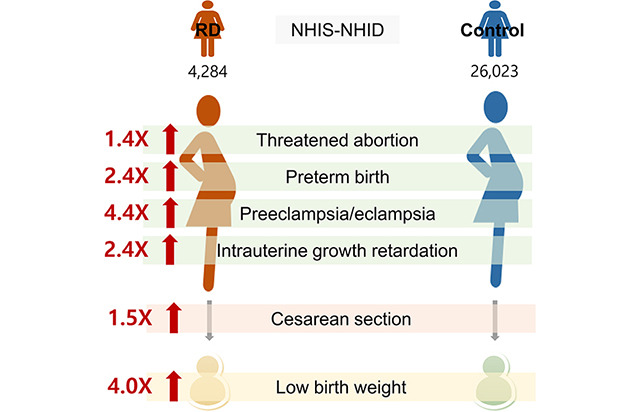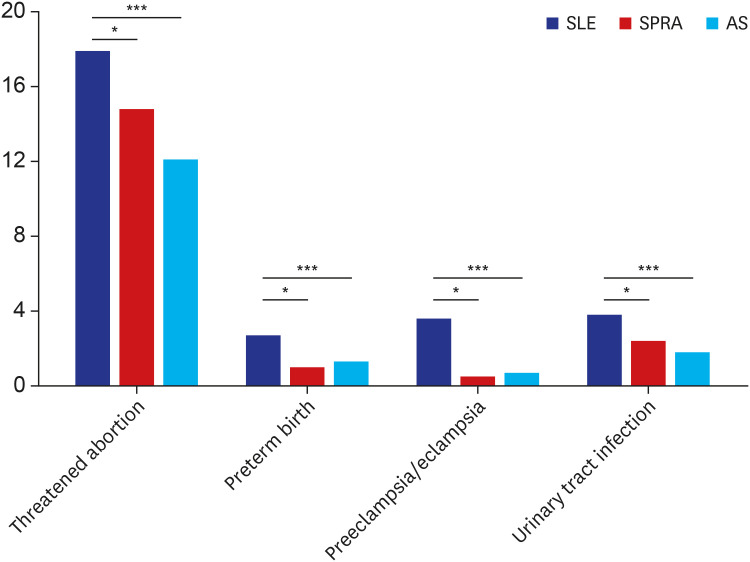1. Timur H, Tokmak A, Türkmen GG, Ali İnal H, Uygur D, Danışman N. Pregnancy outcome in patients with ankylosing spondylitis. J Matern Fetal Neonatal Med. 2016; 29(15):2470–2474. PMID:
26414533.

2. Carvalheiras G, Faria R, Braga J, Vasconcelos C. Fetal outcome in autoimmune diseases. Autoimmun Rev. 2012; 11(6-7):A520–A530. PMID:
22198431.

3. Chung MK, Park JS, Lim H, Lee CH, Lee J. Incidence and prevalence of systemic lupus erythematosus among Korean women in childbearing years: a nationwide population-based study. Lupus. 2021; 30(4):674–679. PMID:
33460342.

4. Weckerle CE, Niewold TB. The unexplained female predominance of systemic lupus erythematosus: clues from genetic and cytokine studies. Clin Rev Allergy Immunol. 2011; 40(1):42–49. PMID:
20063186.

5. Hunter TM, Boytsov NN, Zhang X, Schroeder K, Michaud K, Araujo AB. Prevalence of rheumatoid arthritis in the United States adult population in healthcare claims databases, 2004–2014. Rheumatol Int. 2017; 37(9):1551–1557. PMID:
28455559.

6. Goemaere S, Ackerman C, Goethals K, De Keyser F, Van der Straeten C, Verbruggen G, et al. Onset of symptoms of rheumatoid arthritis in relation to age, sex and menopausal transition. J Rheumatol. 1990; 17(12):1620–1622. PMID:
2084234.

7. Haroon NN, Paterson JM, Li P, Haroon N. Increasing proportion of female patients with ankylosing spondylitis: a population-based study of trends in the incidence and prevalence of AS. BMJ Open. 2014; 4(12):e006634.

8. Mehta B, Luo Y, Xu J, Sammaritano L, Salmon J, Lockshin M, et al. Trends in maternal and fetal outcomes among pregnant women with systemic lupus erythematosus in the United States: a cross-sectional analysis. Ann Intern Med. 2019; 171(3):164–171. PMID:
31284305.
9. Smeele HT, Dolhain RJ. Current perspectives on fertility, pregnancy and childbirth in patients with rheumatoid arthritis. Semin Arthritis Rheum. 2019; 49(3):S32–S35. PMID:
31779849.

10. Park EH, Lee JS, Kim YJ, Lee SM, Jun JK, Lee EB, et al. Pregnancy outcomes in Korean women with ankylosing spondylitis. Korean J Intern Med (Korean Assoc Intern Med). 2021; 36(3):721–730.

11. Chen YJ, Chang JC, Lai EL, Liao TL, Chen HH, Hung WT, et al. Maternal and perinatal outcomes of pregnancies in systemic lupus erythematosus: a nationwide population-based study. Semin Arthritis Rheum. 2020; 50(3):451–457. PMID:
32115237.

12. Jakobsson GL, Stephansson O, Askling J, Jacobsson LT. Pregnancy outcomes in patients with ankylosing spondylitis: a nationwide register study. Ann Rheum Dis. 2016; 75(10):1838–1842. PMID:
26698845.

13. Ostensen M, Ostensen H. Ankylosing spondylitis--the female aspect. J Rheumatol. 1998; 25(1):120–124. PMID:
9458214.
14. Unal C, Fadiloglu E, Tanacan A, Zaim OC, Beksac MS. Retrospective evaluation of pregnancies with ankylosing spondylitis in a tertiary center in Turkey. Int J Rheum Dis. 2020; 23(1):101–105. PMID:
31713329.

15. Kishore S, Mittal V, Majithia V. Obstetric outcomes in women with rheumatoid arthritis: Results from Nationwide Inpatient Sample Database 2003–2011. Semin Arthritis Rheum. 2019; 49(2):236–240. PMID:
30992155.

16. Zbinden A, van den Brandt S, Østensen M, Villiger PM, Förger F. Risk for adverse pregnancy outcome in axial spondyloarthritis and rheumatoid arthritis: disease activity matters. Rheumatology (Oxford). 2018; 57(7):1235–1242. PMID:
29617883.

17. Nørgård BM, Larsen MD, Friedman S, Knudsen T, Fedder J. Decreased chance of a live born child in women with rheumatoid arthritis after assisted reproduction treatment: a nationwide cohort study. Ann Rheum Dis. 2019; 78(3):328–334. PMID:
30636215.

18. Vinet E, Labrecque J, Pineau CA, Clarke AE, St-Pierre Y, Platt R, et al. A population-based assessment of live births in women with systemic lupus erythematosus. Ann Rheum Dis. 2012; 71(4):557–559. PMID:
22084391.

19. Lewis MJ, Jawad AS. The effect of ethnicity and genetic ancestry on the epidemiology, clinical features and outcome of systemic lupus erythematosus. Rheumatology (Oxford). 2017; 56(Suppl 1):i67. 77. PMID:
27940583.

20. Dedmon LE. The genetics of rheumatoid arthritis. Rheumatology (Oxford). 2020; 59(10):2661–2670. PMID:
32638005.

21. Kim HK, Song SO, Noh J, Jeong IK, Lee BW. Data configuration and publication trends for the Korean National Health Insurance and Health Insurance Review & Assessment Database. Diabetes Metab J. 2020; 44(5):671–678. PMID:
33115211.

22. Hochberg MC. Updating the American College of Rheumatology revised criteria for the classification of systemic lupus erythematosus. Arthritis Rheum. 1997; 40(9):1725.

23. Petri M, Orbai AM, Alarcón GS, Gordon C, Merrill JT, Fortin PR, et al. Derivation and validation of the Systemic Lupus International Collaborating Clinics classification criteria for systemic lupus erythematosus. Arthritis Rheum. 2012; 64(8):2677–2686. PMID:
22553077.
24. Neogi T, Aletaha D, Silman AJ, Naden RL, Felson DT, Aggarwal R, et al. The 2010 American College of Rheumatology/European League Against Rheumatism classification criteria for rheumatoid arthritis: Phase 2 methodological report. Arthritis Rheum. 2010; 62(9):2582–2591. PMID:
20872596.

25. van der Linden S, Valkenburg HA, Cats A. Evaluation of diagnostic criteria for ankylosing spondylitis. A proposal for modification of the New York criteria. Arthritis Rheum. 1984; 27(4):361–368. PMID:
6231933.
26. Liu S, Liston RM, Joseph KS, Heaman M, Sauve R, Kramer MS, et al. Maternal mortality and severe morbidity associated with low-risk planned cesarean delivery versus planned vaginal delivery at term. CMAJ. 2007; 176(4):455–460. PMID:
17296957.

27. Wallenius M, Salvesen KA, Daltveit AK, Skomsvoll JF. Systemic lupus erythematosus and outcomes in first and subsequent births based on data from a national birth registry. Arthritis Care Res (Hoboken). 2014; 66(11):1718–1724. PMID:
24839126.

28. Zuppa AA, Riccardi R, Frezza S, Gallini F, Luciano RM, Alighieri G, et al. Neonatal lupus: Follow-up in infants with anti-SSA/Ro antibodies and review of the literature. Autoimmun Rev. 2017; 16(4):427–432. PMID:
28212920.
29. Pastore DE, Costa ML, Surita FG. Systemic lupus erythematosus and pregnancy: the challenge of improving antenatal care and outcomes. Lupus. 2019; 28(12):1417–1426. PMID:
31551036.

30. Keeling SO, Bowker SL, Savu A, Kaul P. A population-level analysis of the differing effects of rheumatoid arthritis and spondyloarthritis on peripartum outcomes. J Rheumatol. 2020; 47(2):197–203. PMID:
31043549.

31. Chung SH, Seol HJ, Choi YS, Oh SY, Kim A, Bae CW. Changes in the cesarean section rate in Korea (1982–2012) and a review of the associated factors. J Korean Med Sci. 2014; 29(10):1341–1352. PMID:
25368486.

32. Bundhun PK, Soogund MZ, Huang F. Impact of systemic lupus erythematosus on maternal and fetal outcomes following pregnancy: a meta-analysis of studies published between years 2001–2016. J Autoimmun. 2017; 79:17–27. PMID:
28256367.

33. Chung MK, Lee CH, Park JS, Lim H, Lee J. Burden of comorbidities and medication use in childbearing women with rheumatic diseases: a nationwide population-based study. Korean J Intern Med. Forthcoming. 2021; DOI: 10.3904/kjim.2021.089.

34. Wallenius M, Salvesen KÅ, Daltveit AK, Skomsvoll JF. Miscarriage and stillbirth in women with rheumatoid arthritis. J Rheumatol. 2015; 42(9):1570–1572. PMID:
26178278.

35. Palmsten K, Hernández-Díaz S, Kuriya B, Solomon DH, Setoguchi S. Use of disease-modifying antirheumatic drugs during pregnancy and risk of preeclampsia. Arthritis Care Res (Hoboken). 2012; 64(11):1730–1738. PMID:
23111855.

36. Harris N, Eudy A, Clowse M. Patient-reported disease activity and adverse pregnancy outcomes in systemic lupus erythematosus and rheumatoid arthritis. Arthritis Care Res (Hoboken). 2019; 71(3):390–397. PMID:
29908013.

37. Bowden AP, Barrett JH, Fallow W, Silman AJ. Women with inflammatory polyarthritis have babies of lower birth weight. J Rheumatol. 2001; 28(2):355–359. PMID:
11246676.
38. Song YJ, Liu DZ, Liu JT, Zhao Y. Predictors of maternal and fetal outcome in systemic lupus erythematosus: a retrospective study of 94 cases. Zhonghua Nei Ke Za Zhi. 2008; 47(12):1008–1011. PMID:
19134306.
39. Vinet É, Genest G, Scott S, Pineau CA, Clarke AE, Platt RW, et al. Brief report: causes of stillbirths in women with systemic lupus erythematosus. Arthritis Rheumatol. 2016; 68(10):2487–2491. PMID:
27159385.

40. Jethwa H, Lam S, Smith C, Giles I. Does rheumatoid arthritis really improve during pregnancy? A systematic review and metaanalysis. J Rheumatol. 2019; 46(3):245–250. PMID:
30385703.

41. de Man YA, Hazes JM, van der Heide H, Willemsen SP, de Groot CJ, Steegers EA, et al. Association of higher rheumatoid arthritis disease activity during pregnancy with lower birth weight: results of a national prospective study. Arthritis Rheum. 2009; 60(11):3196–3206. PMID:
19877045.

42. Gur C, Diav-Citrin O, Shechtman S, Arnon J, Ornoy A. Pregnancy outcome after first trimester exposure to corticosteroids: a prospective controlled study. Reprod Toxicol. 2004; 18(1):93–101. PMID:
15013068.

43. Bramham K, Hunt BJ, Bewley S, Germain S, Calatayud I, Khamashta MA, et al. Pregnancy outcomes in systemic lupus erythematosus with and without previous nephritis. J Rheumatol. 2011; 38(9):1906–1913. PMID:
21632681.

44. Smyth A, Oliveira GH, Lahr BD, Bailey KR, Norby SM, Garovic VD. A systematic review and meta-analysis of pregnancy outcomes in patients with systemic lupus erythematosus and lupus nephritis. Clin J Am Soc Nephrol. 2010; 5(11):2060–2068. PMID:
20688887.

45. Tsai PH, Yu KH, Chou IJ, Luo SF, Tseng WY, Huang LH, et al. Risk of autism spectrum disorder in children born to mothers with systemic lupus erythematosus and rheumatoid arthritis in Taiwan. Joint Bone Spine. 2018; 85(5):599–603. PMID:
29183859.

46. Flint J, Panchal S, Hurrell A, van de Venne M, Gayed M, Schreiber K, et al. BSR and BHPR guideline on prescribing drugs in pregnancy and breastfeeding-Part I: standard and biologic disease modifying anti-rheumatic drugs and corticosteroids. Rheumatology (Oxford). 2016; 55(9):1693–1697. PMID:
26750124.
47. Seo MR, Chae J, Kim YM, Cha HS, Choi SJ, Oh S, et al. Hydroxychloroquine treatment during pregnancy in lupus patients is associated with lower risk of preeclampsia. Lupus. 2019; 28(6):722–730. PMID:
30971164.

48. Guillotin V, Bouhet A, Barnetche T, Richez C, Truchetet ME, Seneschal J, et al. Hydroxychloroquine for the prevention of fetal growth restriction and prematurity in lupus pregnancy: a systematic review and meta-analysis. Joint Bone Spine. 2018; 85(6):663–668. PMID:
29631068.

49. Andreoli L, Bertsias GK, Agmon-Levin N, Brown S, Cervera R, Costedoat-Chalumeau N, et al. EULAR recommendations for women’s health and the management of family planning, assisted reproduction, pregnancy and menopause in patients with systemic lupus erythematosus and/or antiphospholipid syndrome. Ann Rheum Dis. 2017; 76(3):476–485. PMID:
27457513.









 PDF
PDF Citation
Citation Print
Print





 XML Download
XML Download